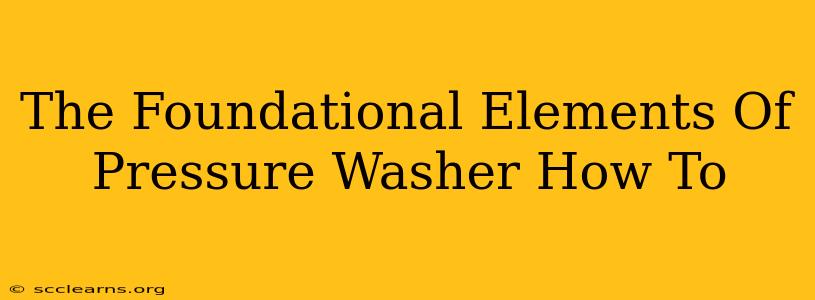Pressure washers are powerful cleaning tools, but understanding their core components is key to effective use and maintenance. This guide breaks down the foundational elements of a pressure washer, empowering you to choose the right one and get the most out of it.
Understanding the Core Components of a Pressure Washer
A pressure washer's effectiveness hinges on the interplay of several key components. Let's delve into each one:
1. The Pump: The Heart of the Machine
The pump is the pressure washer's powerhouse, responsible for generating high-pressure water. Different pump types exist, each with its own advantages and disadvantages:
-
Axial pumps: These are generally more affordable but often less durable and powerful than others. They're suitable for lighter-duty tasks.
-
Radial pumps: Known for their higher pressure output and greater durability, radial pumps are ideal for more demanding cleaning jobs. They're a popular choice for both homeowners and professionals.
-
Triplex pumps: Considered the workhorses of the pressure washer world, triplex pumps offer superior pressure and longevity. Expect to pay more, but the performance justifies the investment for heavy-duty applications.
Choosing the right pump type depends on your anticipated usage. Consider how often you'll use the pressure washer and the types of cleaning jobs you'll tackle.
2. The Motor: Powering the Pump
The motor provides the power to drive the pump. Common motor types include:
-
Gas-powered motors: Offer greater power and longer runtimes without needing to be plugged in. Ideal for larger areas or extensive cleaning projects.
-
Electric motors: Quieter, cleaner, and more convenient to use, but often less powerful than gas counterparts and limited by cord length. Great for smaller projects around the home.
The choice between gas and electric depends on your needs and preferences. Consider the size of the area you need to clean and your access to power sources.
3. The Unloader Valve: Managing Pressure
The unloader valve is a crucial safety feature that releases pressure when the trigger isn't engaged. This prevents the pump from running constantly at high pressure and extends its lifespan. Regular inspection and maintenance of this valve are vital for safe and efficient operation.
4. The Hose and Wand: Delivering the Power
The high-pressure hose connects the pump to the spray wand. This hose must be robust enough to withstand the high pressure generated by the pump. Regular inspection for wear and tear is essential. The wand is where you'll attach the nozzle to control the spray pattern and pressure.
5. The Nozzle: Controlling the Spray Pattern
The nozzle is the final component that determines the spray pattern and intensity. Different nozzles offer varied spray patterns, from pencil jets for precise cleaning to wide fan sprays for covering large areas. Knowing how to use different nozzle types effectively is essential for optimal cleaning results.
Choosing the Right Pressure Washer
Selecting the right pressure washer depends on your specific needs. Consider these factors:
-
PSI (Pounds per Square Inch): This measures the water pressure. Higher PSI is generally needed for tougher cleaning jobs.
-
GPM (Gallons Per Minute): This indicates the volume of water flowing per minute. Higher GPM allows for faster cleaning.
-
Power Source: Decide between gas and electric based on power requirements and convenience.
-
Intended Use: Consider the type of cleaning tasks you'll be undertaking.
By understanding these foundational elements, you'll be better equipped to choose and use a pressure washer effectively, maximizing its cleaning power and extending its lifespan. Remember to always prioritize safety and follow the manufacturer's instructions for proper operation and maintenance.

